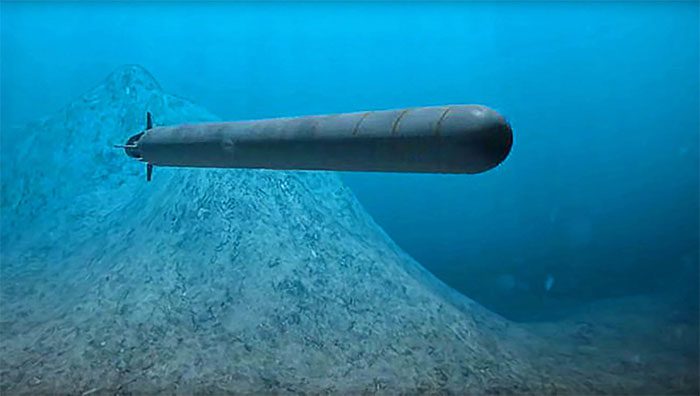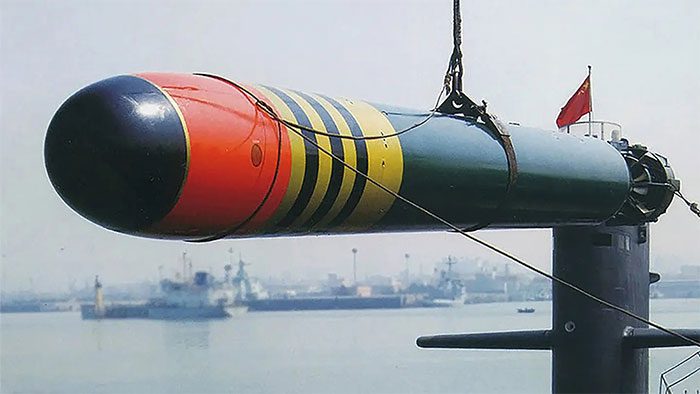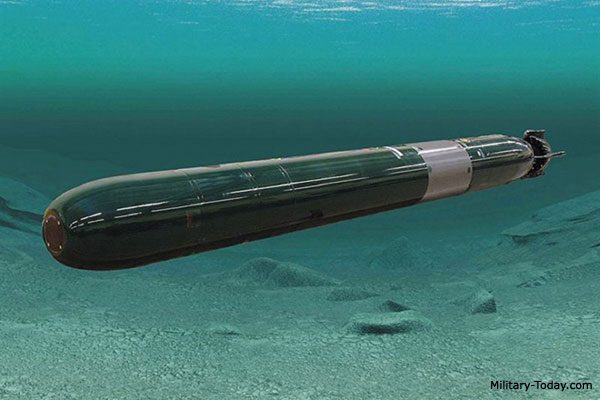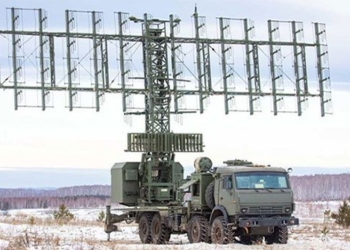A research group in Beijing has announced that they have completed the design of a low-cost small nuclear reactor concept, capable of enabling torpedoes to traverse the Pacific Ocean in about a week.
According to the South China Morning Post, Chinese researchers are developing a mini version of the Poseidon unmanned submarine created by Russia – the world’s first underwater drone powered by nuclear energy.

Russian Poseidon nuclear torpedo. (Photo: Twitter)
Scientists have stated that unlike the Poseidon, the mini version can be fitted into a standard torpedo launch tube and launched in large quantities from almost any submarine or warship.
Each torpedo will utilize a disposable nuclear reactor capable of speeds over 30 knots (56 km/h) for 200 hours, before discarding the reactor to the seabed and relying on batteries to conduct a conventional weapon attack.
In an article published in the Journal of Unmanned Undersea Systems, scientist Guo Jian from the China Atomic Energy Institute noted that the vehicle they are designing has fundamental differences from the Poseidon.
“Thanks to its high flexibility and low cost, this underwater drone equipped with a nuclear power system can be used as a conventional force, similar to an attack submarine, rather than a nuclear missile,” Guo stated.

Chinese-flagged torpedo. (Illustration: The Drive)
According to Russian media, the 2-megaton nuclear warhead of the Poseidon can destroy a coastal city or a larger area. However, Chinese researchers have indicated that using such a weapon could lead to nuclear war. Instead, the Poseidon primarily serves as a type of strategic weapon.
Guo also mentioned that the demand for China’s mini long-range underwater drones is increasing. These types of vehicles are favored for their high speed, long range, compact size, and versatility in reconnaissance, monitoring, attacking, and strategic strikes.
Nuclear energy can provide enormous amounts of power to support these missions, but most current reactors are complex in structure and expensive. Guo stated: “To build a new nuclear power system with simple, user-friendly, and maintainable technology that is cost-effective and can be mass-produced, we need to think carefully.”
For the new design, the project team has removed most of the shielding materials from the reactor, protecting only some critical components from radiation. They also replaced expensive rare-earth element coatings inside the reactor core with cheaper materials like graphite. To further cut costs, scientists proposed using some commercially available equipment instead of military-grade products.

The Poseidon super torpedo is considered a powerful weapon of the Russian military. (Photo: MT)
The new Chinese reactor, weighing as much as two adult men, will generate over 1.4 megawatts of thermal energy with less than 4 kg of low-enriched uranium fuel. According to Guo’s calculations, only about 6% of the generated heat will be converted into electrical energy to propel the torpedo, due to the low efficiency of the inexpensive components. However, this energy is more than sufficient for a one-way trip.
“When manufacturing costs are low enough, even if the nuclear-powered device can only be used once, the overall cost will be low. This drives us to design a simpler and more compact system,” the researchers stated.
Additionally, because the mini reactor will not produce radiation, maintenance personnel can handle it without protective gear.
The chain reaction will start immediately after the torpedo leaves the launch pad, taking about half an hour to reach an operational temperature of 300 degrees Celsius and accelerate the torpedo to a speed of approximately 60 km/h.
Researchers estimate that the reactor can operate for 400 hours, covering over 10,000 km. After that, it will detach from the torpedo and fall to the deep seabed, activating a safety mechanism to eliminate the remaining chain reaction.
Even if the hull is damaged, filled with water, and the body falls into the moist sand at the seabed, the reactor will not cause a serious accident. All safety issues are ensured.
Ma Liang, a submarine launch technology researcher at the Naval Submarine Academy in Qingdao, Shandong Province, assessed that the “smart torpedo” will play a crucial role in future maritime battles. She stated that artificial intelligence technologies, such as machine learning, will enable torpedoes to select and attack targets without or with minimal human intervention.
It could also set up an ambush on the other side of the ocean and attack submarines as they leave port, where manned launch platforms may be difficult to access. The torpedoes can also receive commands from humans or an unmanned underwater command vehicle to perform a variety of missions, such as reconnaissance and tracking high-value targets. Researcher Ma emphasized: “This is currently the most dynamic field of technology research.”




















































